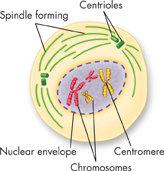▸ G2 Phase: Preparing for Cell Division When DNA replication is completed, the cell enters the G2 phase. G2 is usually the shortest of the three phases of interphase. During the G2 phase, many of the organelles and molecules required for cell division are produced. When the events of the G2 phase are completed, the cell is ready to enter the M phase and begin the process of cell division.
▸ M Phase: Cell Division The M phase of the cell cycle, which follows interphase, produces two daughter cells. The M phase takes its name from the process of mitosis. During the normal cell cycle, interphase can be quite long. In contrast, the process of cell division usually takes place quickly.
In eukaryotes, cell division occurs in two main stages. The first stage of the process, division of the cell nucleus, is called mitosis (my TOH sis). The second stage, the division of the cytoplasm, is called cytokinesis (sy toh kih NEE sis). In many cells, the two stages may overlap, so that cytokinesis begins while mitosis is still taking place.
BUILD Vocabulary
WORD ORIGINS The prefix cyto- in cytokinesis refers to cells and derives from the Greek word kytos, meaning “a hollow vessel.” Cytoplasm is another word that has the same root.
Mitosis
 What events occur during each of the four phases of mitosis?
What events occur during each of the four phases of mitosis?
Biologists divide the events of mitosis into four phases: prophase, metaphase, anaphase, and telophase. Depending on the type of cell, mitosis may last anywhere from a few minutes to several days. Figure 10–8 through Figure 10–11 show mitosis in an animal cell.
Prophase The first phase of mitosis, prophase, is usually the longest and may take up to half of the total time required to complete mitosis.  During prophase, the genetic material inside the nucleus condenses and the duplicated chromosomes become visible. Outside the nucleus, a spindle starts to form.
During prophase, the genetic material inside the nucleus condenses and the duplicated chromosomes become visible. Outside the nucleus, a spindle starts to form.
The duplicated strands of the DNA molecule can be seen to be attached along their length at an area called the centromere. Each DNA strand in the duplicated chromosome is referred to as a chromatid (KROH muh tid), or sister chromatid. When the process of mitosis is complete, the chromatids will have separated and been divided between the new daughter cells.
Also during prophase, the cell starts to build a spindle, a fanlike system of microtubules that will help to separate the duplicated chromosomes. Spindle fibers extend from a region called the centrosome, where tiny paired structures called centrioles are located. Plant cells lack centrioles, and organize spindles directly from their centrosome regions. The centrioles, which were duplicated during interphase, start to move toward opposite ends, or poles, of the cell. As prophase ends, the chromosomes coil more tightly, the nucleolus disappears, and the nuclear envelope breaks down.
Metaphase The second phase of mitosis, metaphase, is generally the shortest.  During metaphase, the centromeres of the duplicated chromosomes line up across the center of the cell. Spindle fibers connect the centromere of each chromosome to the two poles of the spindle.
During metaphase, the centromeres of the duplicated chromosomes line up across the center of the cell. Spindle fibers connect the centromere of each chromosome to the two poles of the spindle.

Table of Contents
- Formulas and Equations
- Applying Formulas and Equations
- Mean, Median, and Mode
- Estimation
- Using Measurements in Calculations
- Effects of Measurement Errors
- Accuracy
- Precision
- Comparing Accuracy and Precision
- Significant Figures
- Calculating With Significant Figures
- Scientific Notation
- Calculating With Scientific Notation
- Dimensional Analysis
- Applying Dimensional Analysis






